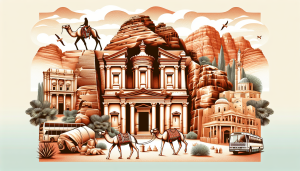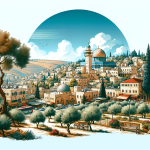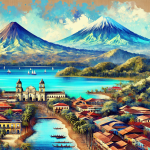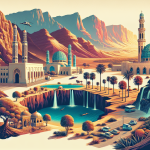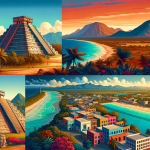Discover the Magic of Jordan: A Journey Through Time and Culture
When it comes to experiencing a land rich in history, culture, and natural beauty, few countries can match the allure of Jordan. Nestled in the heart of the Middle East, Jordan is a destination that captivates travelers with its ancient ruins, stunning landscapes, and warm hospitality. Whether you’re a history buff eager to explore ancient civilizations, an adventure seeker craving thrilling experiences, or a culture enthusiast wanting to immerse yourself in local traditions, Jordan has something to offer everyone. In this comprehensive guide, we will delve into the myriad wonders that make Jordan a must-visit destination. From the iconic Petra and the otherworldly Wadi Rum to the serene waters of the Dead Sea and the bustling capital city of Amman, join us as we uncover the magic of Jordan.
Petra: The Rose-Red City
Petra, often referred to as the “Rose-Red City” due to the color of the rock from which it is carved, is undoubtedly Jordan’s most famous attraction. This UNESCO World Heritage Site is a testament to the ingenuity and craftsmanship of the Nabataeans, an ancient Arab people who established Petra as their capital in the 4th century BC.
The Treasury (Al-Khazneh)
The most iconic structure in Petra is the Treasury, or Al-Khazneh, which greets visitors at the end of the narrow Siq. This towering façade, intricately carved into the sandstone cliff, leaves visitors in awe of its grandeur and detail. The Treasury is believed to have been the mausoleum of Nabataean King Aretas IV and is a prime example of the architectural prowess of the Nabataeans.
The Monastery (Ad-Deir)
Another must-see site within Petra is the Monastery, or Ad-Deir. A bit of a hike from the main trail, the Monastery is even larger than the Treasury and offers breathtaking views of the surrounding landscape. The journey to the Monastery, which involves climbing approximately 800 steps, is as rewarding as the destination itself.
Exploring Petra by Night
For a truly magical experience, consider visiting Petra by Night. This special event allows visitors to explore the Siq and the Treasury lit by the soft glow of candles, accompanied by traditional Bedouin music. It’s an unforgettable way to experience the mystical ambiance of this ancient city.
Wadi Rum: The Valley of the Moon
Wadi Rum, also known as the Valley of the Moon, is a desert landscape unlike any other. Its vast stretches of red sand dunes, dramatic rock formations, and ancient petroglyphs create a surreal environment that has been the backdrop for numerous films, including “Lawrence of Arabia” and “The Martian.”
Exploring by Jeep and Camel
One of the best ways to explore Wadi Rum is by taking a jeep tour, which allows you to cover more ground and see the diverse landscapes of the desert. Alternatively, for a more traditional experience, you can opt for a camel ride, following in the footsteps of the Bedouins who have called this desert home for centuries.
Stargazing in the Desert
Wadi Rum is also renowned for its clear night skies, making it a prime location for stargazing. Spending a night in a Bedouin camp offers a unique opportunity to witness the brilliance of the Milky Way and countless constellations, far from the light pollution of urban areas.
The Dead Sea: A Natural Wonder
The Dead Sea, the lowest point on Earth, is a natural wonder that offers a one-of-a-kind experience. The high salinity of its waters allows visitors to float effortlessly, creating a sensation unlike any other. Additionally, the mineral-rich mud of the Dead Sea is renowned for its therapeutic properties, making it a popular destination for wellness and relaxation.
Floating and Mud Baths
Floating in the Dead Sea is a must-do activity for any visitor to Jordan. The buoyancy of the water makes it nearly impossible to sink, providing a relaxing and unique experience. After floating, many visitors enjoy covering themselves in the therapeutic mud found along the shore, which is said to benefit the skin.
Visiting the Dead Sea Resorts
The area around the Dead Sea is home to several luxury resorts that offer a range of amenities, including spa treatments, pools, and private beach access. These resorts provide the perfect setting for a day of relaxation and rejuvenation.
Amman: The Vibrant Capital
Amman, the capital city of Jordan, is a bustling metropolis that seamlessly blends ancient history with modernity. With its rich cultural heritage, vibrant markets, and diverse culinary scene, Amman offers a captivating glimpse into contemporary Jordanian life.
Historical Sites in Amman
Amman boasts several historical sites that are worth exploring. The Amman Citadel, perched on one of the city’s seven hills, offers panoramic views and houses significant archaeological remains, including the Temple of Hercules and the Umayyad Palace. The Roman Theater, located in the heart of downtown Amman, is another impressive structure that dates back to the 2nd century AD and is still used for cultural events today.
Exploring the Markets
One of the best ways to experience the vibrancy of Amman is by exploring its markets, or souks. The bustling Al-Balad area is home to numerous stalls selling everything from spices and textiles to jewelry and traditional handicrafts. For a more modern shopping experience, head to the Abdali Boulevard, a lively district with upscale shops, cafes, and restaurants.
Savoring Jordanian Cuisine
No visit to Amman would be complete without indulging in the local cuisine. Jordanian food is a delightful blend of Mediterranean and Middle Eastern flavors, with dishes such as mansaf (a traditional lamb and yogurt dish), falafel, and mezze (a selection of small dishes) being must-tries. For a truly authentic experience, consider dining at one of the city’s many family-run restaurants.
Jerash: The Pompeii of the East
Located north of Amman, Jerash is often referred to as the “Pompeii of the East” due to its exceptionally well-preserved Roman ruins. This ancient city, which flourished under Roman rule, offers a fascinating glimpse into the grandeur of the Roman Empire.
The Oval Plaza and Cardo Maximus
The Oval Plaza, a unique and impressive public space, is one of the highlights of Jerash. This elliptical forum is surrounded by colonnades and serves as a focal point for the city’s streets. The Cardo Maximus, the main colonnaded street, stretches through the heart of Jerash and is lined with shops, temples, and public buildings.
The Temple of Artemis
The Temple of Artemis, dedicated to the goddess of the hunt, is another must-see site in Jerash. The temple’s towering columns and intricate carvings showcase the architectural prowess of the ancient Romans.
The North and South Theaters
Jerash is home to two well-preserved theaters, the North Theater and the South Theater. Both theaters are still used for performances today, and attending an event in these ancient venues offers a unique connection to the past.
Aqaba: Jordan’s Gateway to the Red Sea
Aqaba, located on the southern tip of Jordan, is the country’s only coastal city and a popular destination for those seeking sun, sea, and adventure. With its stunning coral reefs, vibrant marine life, and a range of water activities, Aqaba is a paradise for beach lovers and water sports enthusiasts.
Snorkeling and Diving
The Red Sea is renowned for its crystal-clear waters and diverse marine ecosystem, making it a premier destination for snorkeling and diving. Aqaba offers several dive sites, including the famous Cedar Pride shipwreck and the Japanese Gardens, where divers can explore vibrant coral reefs and encounter a variety of marine species.
Water Sports and Beach Activities
In addition to snorkeling and diving, Aqaba offers a range of water sports, including windsurfing, jet skiing, and parasailing. The city’s pristine beaches provide the perfect setting for relaxation and sunbathing.
Exploring Aqaba’s History
Aqaba is not just about the sea; it also has a rich history waiting to be explored. The Aqaba Fort, also known as Mamluk Castle, dates back to the 16th century and offers insight into the city’s past. The Aqaba Archaeological Museum, located nearby, houses artifacts that trace the region’s history from ancient times to the Islamic era.
Madaba and Mount Nebo: Biblical Landmarks
Madaba and Mount Nebo are two significant biblical landmarks located near each other, making them ideal for a combined visit. These sites offer a fascinating glimpse into Jordan’s religious history and provide breathtaking views of the surrounding landscape.
The Mosaic Map of Madaba
Madaba is famous for its Byzantine-era mosaics, the most notable of which is the Madaba Map. This ancient mosaic map, located in the Church of St. George, depicts the Holy Land and is the oldest surviving map of the region. The intricate details and historical significance of the Madaba Map make it a must-see for visitors.
Mount Nebo: A Pilgrimage Site
Mount Nebo is traditionally believed to be the site where Moses viewed the Promised Land before his death. Today, it is a pilgrimage site for Christians and offers panoramic views of the Jordan Valley, the Dead Sea, and, on clear days, Jerusalem. The Memorial Church of Moses, located on Mount Nebo, contains beautiful mosaics and serves as a place of reflection and worship.
The Jordan Trail: Hiking Through History
For those who love outdoor adventures, the Jordan Trail offers an incredible opportunity to hike through the country’s diverse landscapes and historical sites. This long-distance trail stretches over 400 miles (650 kilometers) from the northern town of Umm Qais to the southern port city of Aqaba.
Northern Section: Umm Qais to Ajloun
The northern section of the Jordan Trail takes hikers through lush forests, olive groves, and ancient ruins. Highlights of this section include the ruins of Gadara in Umm Qais, the Ajloun Castle, and the picturesque village of Orjan.
Central Section: Dana to Petra
The central section of the trail is often considered the most challenging and rewarding. Hikers will traverse the Dana Biosphere Reserve, Jordan’s largest nature reserve, and make their way to Petra. This section offers stunning landscapes, including canyons, mountains, and remote villages.
Southern Section: Wadi Rum to Aqaba
The southern section of the Jordan Trail leads hikers through the dramatic desert landscapes of Wadi Rum and ends in the coastal city of Aqaba. This section provides an opportunity to experience the stark beauty of the desert and the vibrant marine life of the Red Sea.
Conclusion
Jordan is a country that offers a wealth of experiences for travelers of all interests. From the ancient wonders of Petra and Jerash to the natural beauty of Wadi Rum and the Dead Sea, and from the vibrant city life of Amman to the tranquil shores of Aqaba, Jordan is a destination that promises unforgettable memories. Whether you’re exploring historical sites, embarking on outdoor adventures, or simply soaking in the local culture and cuisine, Jordan invites you to discover its rich tapestry of history, nature, and hospitality. So pack your bags and get ready to embark on a journey through time and culture in the magical land of Jordan.
For more information on planning your trip to Jordan, visit Visit Jordan.
